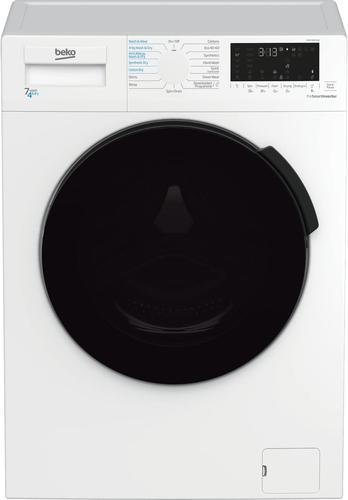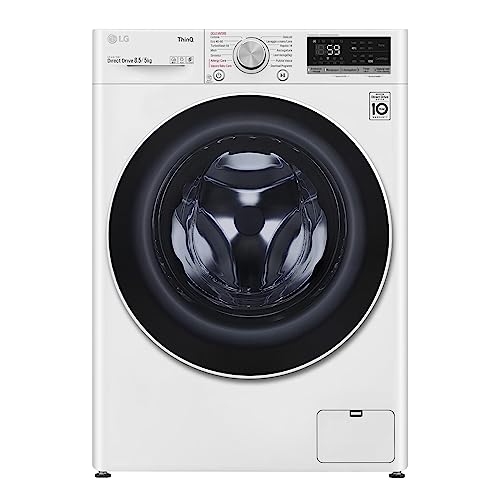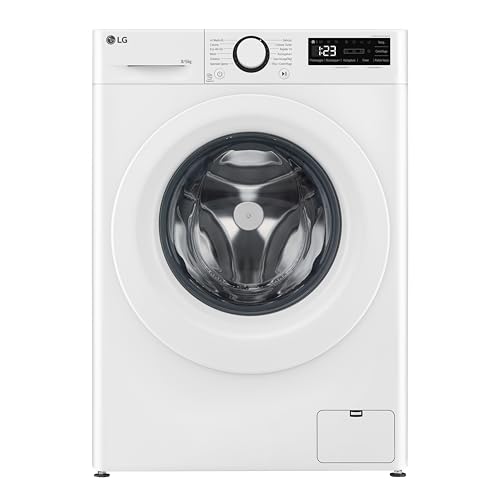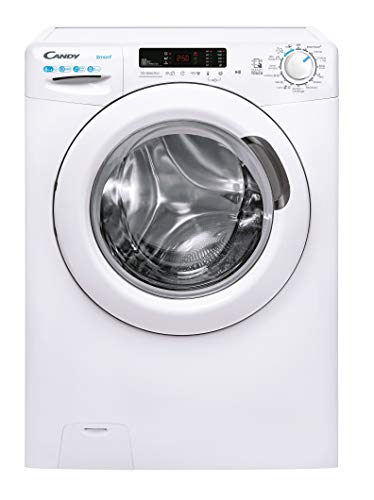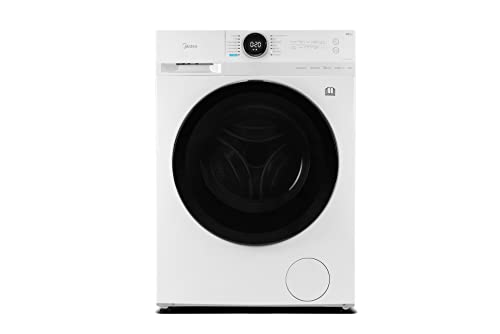How deep are slim washer-dryers?
A washer dryer is considered slim if it has a depth of 50 cm or less. Super-slim washer dryers have a depth of 45 cm or less. These models help you save space, especially in small laundry areas or bathrooms, but they still include full washing and drying functions.
You can find slim washer dryers that combine performance with compact design. Super-slim versions go even further in saving space, so they work well if you need to fit your appliance into narrow or shallow areas. Although these machines take up less room, they still handle everyday laundry needs. You get full wash and dry cycles inside a tighter footprint.
Are slim washer-dryers good?
Slim washer-dryers achieve an average overall score of 7.3 points and user rating of 7.8 points. The average washer-dryer on the market has an overall score of 7.3 points and user rating of 7.9 points. Slim washer-dryers suit small spaces and work well if you need a compact model.
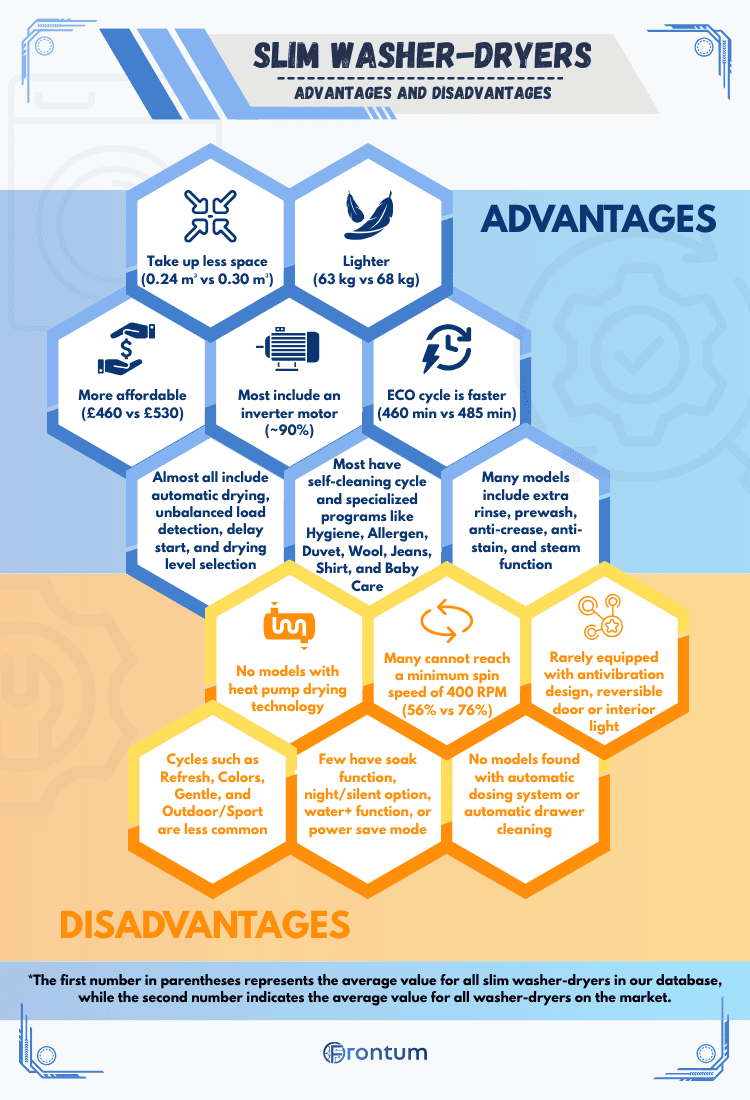
What are the main advantages of slim washer-dryers?
The main advantages of slim washer-dryers compared to non-slim washer-dryers are as follows:
- Lower price: Slim washer-dryers cost about £70 less than the market average (£480 vs £550)
- Smaller size: Slim washer-dryers take up about 20% less space than non-slim models (0.24 m³ vs 0.30 m³)
- Lighter weight: Slim washer-dryers weigh about 5 kg less than the market average (63 kg vs 68 kg)
- Inverter motor in most models: Around 90% of slim washer-dryers include an inverter motor
- Similar energy consumption: Slim washer-dryers use about 56 kWh per 100 cycles, same as the market average
- Same water usage: Slim washer-dryers use 48 litres per washing cycle, matching the market average
- Shorter ECO cycle: Slim washer-dryers complete the combined ECO cycle about 25 minutes faster than the market average (460 min vs 485 min)
- More advanced programs: About 94% of slim washer-dryers include a self-cleaning cycle and many have special programs like Hygiene, Allergen, Duvet, Wool, Jeans, Shirt and Baby Care
- Extra functions included: Some slim washer-dryers include Extra Rinse, Prewash, Anti-crease, Anti-stain, Steam and Fast cycle options
- Similar feature count: Slim washer-dryers have an average of 16 features, which is close to the market average
- Common smart functions: Almost all slim washer-dryers include automatic drying, unbalanced load detection, delay start, selectable drying level, selectable drying times and Pause & Add feature
What are the main disadvantages of slim washer-dryers?
The disadvantages of slim washer-dryers compared to standard washer-dryers are as follows:
- No heat pump drying: We have not found any slim washer-dryer that uses heat pump technology for drying.
- Lower spin speed range: Only about 56% of slim washer-dryers can reach the minimum spin speed of 400 RPM, while 99% of washer-dryers on the market can reach it.
- Fewer special cycles: Slim washer-dryers less commonly include programs like Refresh, Colors, Gentle or Outdoor/Sport compared to other washer-dryers.
- Limited extra functions: Only a few slim washer-dryers include a Soak function and none include Night/Silent option, Water+ function or Power Save mode.
- Lack of convenience features: Only a few slim washer-dryers include anti-vibration design and none include a reversible door or interior drum light.
- No automatic systems: We have not found any slim washer-dryer with automatic detergent dosing or automatic drawer cleaning.
How much do slim washer-dryers cost?
Slim washer-dryers usually cost from about £290 up to £550, and the average price is around £480 (about £70 cheaper than the market average that sits at £550).
The following chart shows the price distribution for slim washer-dryers.
[vertical-chart-10438711283014109]
What should you consider while choosing the best slim tumble dryer?
When choosing the best slim tumble dryer, check the drying capacity and drum volume. These two factors decide how much laundry the machine can handle at once and how efficient it dries clothes. Look at the overall dimensions to confirm it fits your space. Energy consumption also matters because it affects running costs over time. The motor type can affect noise levels and durability. Focus on the available drying programs and features that match your needs, like settings for delicate fabrics or Quick-dry cycles.
What is the most common type of slim washer-dryers?
The most common type of slim washer-dryers uses condenser technology. We have not found many slim washer-dryer that uses heat pump technology for drying.
You usually find condenser dryers in slim models because they take up less space and cost less to build than heat pump dryers. Heat pump technology needs more internal components, so it usually appears in larger washer-dryers.
What capacities are available for slim washer-dryers?
Slim washer-dryers have a washing capacity between 6 and 9 kg and a drying capacity between 4 and 6 kg. The most common combinations are 8/6 kg (about 31%), 8/5 kg (about 19%) and 7/4 kg (about 19%).
Drum volume stays at or below 58 L (market average is 60 L). These models take up between 0.22 and 0.25 m³ of space. On average, they use around 0.24 m³, so they need about 20% less space than non-slim washer-dryers, which usually occupy 0.30 m³.
Weight ranges from 61 to 71 kg, and the average model weighs about 63 kg. This makes them around 5 kg lighter than the typical washer-dryer, which weighs 68 kg.
The capacity distribution for slim washer-dryers is illustrated in the chart below.
[pie-chart-13735713725814999]
How energy-efficient are slim washer-dryers?
Slim washer-dryers have lower energy efficiency compared to the overall market. For washing energy efficiency, most slim washer-dryers fall under class A (about 44%), followed by class C (about 25%) and class D (about 25%), while only around 6% belong to class B. You won’t find slim models with class E in washing efficiency. These numbers show that slim models usually rank below the market average, where about 48% of all washer-dryers belong to class A, 19% to class B, 18% to class C, 12%to class D and 3% to class E.
Combined energy efficiency in slim washer-dryers also falls behind. Around 75% belong to class E, while 13% fall into class D and another 13% into class F. None of the slim washer-dryers we reviewed belong to class A, B or C. In comparison, the overall market shows better distribution with less than 1% in class A, 1% in class B, 1% in class C, 41% in class D, 49% in class E and 4% in class F.
You can expect energy use in slim washer-dryers to range from 42 to 69 kWh per 100 washing cycles. Average use stands at 56 kWh, which stays close to the market average of 55 kWh. For combined cycles, energy use ranges from 216 to 397 kWh per 100 cycles, with an average of 326 kWh—slightly higher than the market average of 318 kWh.
Water consumption also follows similar trends. Per washing cycle, slim washer-dryers usually use between 34 and 50 litres, with an average of 48 litres, same as the market. For combined cycles, they use 46 to 90 litres, averaging 80 litres per cycle, close to the market average of 79 litres.
Energy efficiency classes for slim washer-dryers are represented in the following chart.
[pie-chart-22747822332220034]
What is the spin-drying efficiency of slim washer-dryers?
Spin-drying efficiency of slim washer-dryers usually falls into class B. Most models in this category belong to this class. Spin efficiency in slim washer-dryers performs slightly worse than the overall market average, where 14% reach class A, 84% belong to class B, and less than 1% fall into class C.
Spin-drying efficiency class depends heavily on the maximum spin speed. Slim washer-dryers usually reach between 1200 RPM and 1400 RPM. Around 50% of slim models spin at 1400 RPM, which is the most common. Only about 56% of slim washer-dryers can reach the minimum spin speed of 400 RPM, while 75% of washer-dryers in the overall market can do this.
How loud are slim washer-dryers?
Slim washer-dryers are very similar to non-slim washer-dryers in terms of noisiness.
You can expect the following noise levels from slim washer-dryers:
- Spin noise: ranges from 71 to 79 dB (average 75 dB), which matches the market average
- Washing noise: usually stays between 54 and 56 dB (average 55 dB), which is close to the market average of 54 dB
- Drying noise: usually ranges from 54 to 66 dB (average 59 dB), which is the same as the market average
Noise emission classes in slim washer-dryers usually fall between class A and class C. Most models fall into class B (about 50%), followed by class A (about 38%) and class C (about 12%). The overall market shows 38% of washer-dryers in class A, 31% in class B, 24% in class C, and 6% in class D. Slim washer-dryers follow a similar pattern.
How many washing & drying programs do slim washer-dryers offer?
Slim washer-dryers have usually 11–17 washing and drying programs, with an average of 13 programs. This matches the average for most other washer-dryers.
Most slim washer-dryers include the basic programs such as Eco 40-60, Cottons, Synthetics, Mix, and Wash&Dry.
You also get specialized programs in many models, as follows:
- Wool (in ~90% of slim washer-dryers)
- Allergen (in ~75%)
- Hygiene (in ~60%)
- Duvet (in ~45%)
- Baby Care (in ~25%)
- Jeans (in ~20%)
- Shirt (in ~20%)
Self-cleaning cycle appears in ~95% of slim washer-dryers.
Some cycles are less common in slim washer-dryers than in most other washer-dryers. These include the following programs:
- Refresh (in ~40% vs 75% market share overall)
- Gentle (in ~40% vs 100%)
- Outdoor/Sport (in ~20% vs 100%)
- Colors (in ~5% vs 100%)
Eco washing cycle in slim washer-dryers runs from 200 to 230 minutes (average is 220 minutes), same as the market average. Combined Eco cycle (Eco + cupboard drying level) runs from 420 to 610 minutes, with an average of 460 minutes, which is 25 minutes less than the market average of 485 minutes.
Which washing/drying functions do slim washer-dryers have?
Slim washer-dryers include the following washing and drying functions.
- Prewash function (~100%)
- Steam function (~90%)
- Extra Rinse function (~70%)
- Fast cycle option (~50%)
- Anti-stain function (~40%)
- Anti-crease function (~30%)
Only a few models include the Soak function. You will not find slim washer-dryers with Night/Silent option, Water+ function or Power Save mode. These are rare across most models.
You can expect the core functions like Prewash and Steam function in nearly all slim washer-dryers. Extra Rinse appears in about 70% of them. Around half include a Fast cycle option. Fewer have Anti-stain (~40%) or Anti-crease (~30%). Soak remains uncommon. You will not see Night/Silent, Water+, or Power Save mode in this type.
These patterns reflect most slim washer-dryers in the 455£ range.
What features do slim washer-dryers include?
Slim washer-dryers include from 13 to 20 advanced features. Most models have around 16 features, which is close to the market average of 15 features.
Almost all slim washer-dryers include these features:
- Automatic drying
- Unbalanced load detection
- Delay start option
- Selectable drying level
- Selectable drying times
- Pause & Add Feature
Other common features in slim washer-dryers are as follows:
- Laundry detection system (~75%):
- Smart Diagnosis (~70%):
- Favorite function (~55%):
- Foam control system (~50%):
- Automatic load balancing during spin (~45%):
- Wi-Fi Connectivity (~30%):
- AI Technology (~30%):
- Acqua Stop (~25%):
- Pre-mix Technology (~20%):
Around 90% of slim washer-dryers use an inverter motor.
About 60% include a special drum design for delicate clothes. A few have antivibration design. We have not found any models with reversible door or interior light.
No slim washer-dryer includes automatic dosing system or automatic drawer cleaning.

